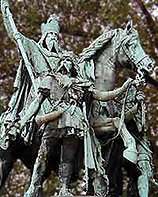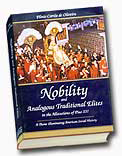This year we celebrate the 15th anniversary of the launching of the book: Nobility and Analogous
Traditional Elites. This last work of ![]()
Prof. Plinio Corrêa de Oliveira outlines a true program to bring the world out of the chaos into which it is sinking. It indicates the path for an authentic restoration of Christian Civilization in our days. The book’s eternal truths remain ever timely.
Plinio Corrêa de Oliveira treated the pontifical documents against the errors of our days with a veneration that surpassed enthusiasm. He took a special ardent joy in those documents that fought the egalitarian doctrines originating in the French Revolution which later became the foundation of communism. This can be seen in his first book, In Defense of Catholic Action, and in his last, Nobility and Analogous Traditional Elites in the Allocutions of Pius XII.
This year we commemorate, respectively, sixty and fifteen years since the launching of these works. This article will take a special look at the background and timeliness of the book on nobility and elites in society.
1943 – 1993 – 2008
His first work, In Defense of Catholic Action, defended the internal order of the Church, threatened by egalitarian ideas.1 Professor Plinio Corrêa de Oliveira focused on a doctrinal error, whereby elements of the laity of the Catholic Action claimed for themselves powers and dignities inherent to the Sacred Hierarchy due to the priesthood’s very nature.2 The thesis of In Defense of Catholic Action was later confirmed by documents of the Supreme Magisterium of the Church.3
His last book on the role of elites could have been titled, In Defense of the Catholic Social Order. It was the crowning work of a life spent defending the fundamental principles of Christian Civilization. Just as the name of a church appears above its doorway, the name of this incomparable apostle, dubbed “The Crusader of the Twentieth Century,”4 is written above an imaginary doorway of an edifice that spans half a century.
Nobility and Traditional Elites
Throughout history, no institution or political party ever did as much for working men as the Catholic Church. Innumerable saints were dedicated to the most needy. One reason the majority of canonized saints are nobles5 is their inherent drive to protect the least-favored of society.6
Whether in war or at peace, the nobility has given countless examples of heroism and sanctity throughout history. However, since the French Revolution of 1789 the nobility has been the victim of a black legend. Historians and authors constantly defame nobility and, in so doing, degrade the leaders and models of society. This lack of role models has helped the unprecedented religious and moral squalor of our times to advance.

After Charlemagne's great empire was destroyed, primitive Europe was thrown into chaos. The nascent nobility helped pick up the pieces.
The Historical Formation of the Nobility
After his death, the great empire of Charlemagne (768-814) was slowly destroyed by successive barbarian invasions. With these invasions, Europe entered into a long period of upheaval. Cities were destroyed; roads were made impassible; and churches and convents were sacked.
During this nascent period of Christendom, the scorched earth produced practically nothing. There was neither law nor order. These primitive Europeans dared not leave their hamlets, where they survived in fear and poverty. In face of this calamity, the helpless populations clamored for protection.
Responding to these cries, local leaders arose who distinguished themselves in the defense of their families and villages. They manifested true courage in repressing the invading hordes. They also distinguished themselves by their methods of organizing civil life during times of peace – above all in financial and agricultural matters. They acted simultaneously as land managers and war leaders and thus became known as administrators. Later they became known as lords.
Their fortifications were emerging castles; they were the nascent nobility. “From the spontaneous circumstances of history, the figure of the landowner-lord emerged.”7
Nascent Nobility
Fortified by charity and the preaching of a flourishing Church, the bonds that formed between the people and their lord closely imitated those which exist within the family.
Each lord’s peacetime duties were to fortify the citadel, organize production, maintain justice and protect the village from wild beasts. The nature of these social relations were such that: “in the past it could be said that in the home, even the most modest home, the father was the king of his children, while at the summit, the king was the father of fathers.”8
The history of France, Germany and Hungary shows that these lords joined together under more powerful lords with greater dominions by this same organic process of amalgamation. In periods of peace and war, each tier of this ascending staircase of lords assumed duties which were intrinsically more difficult and noble than those below them. Thus, the lords formed a series of concentric circles of influence that was crowned by the king.
This colossal process of defining and organizing the nobility was fruit of the practice of virtue. Obviously, it also suffered from the miseries inherent to any human group. However, through the Church’s influence and the organic nature of this process even human misery was largely checked. In spite of the black legend of our day, the word noble still evokes the idea of elevated abnegation.

The cruel blade of the guillotine was indifferent to the service that generations of France's illustrious lineages had given to the country.
Revolutionary Republics
In this context, it is entirely reasonable that St. Thomas Aquinas9 and Pius VI10 taught that monarchy is the best form of government. However, they also taught that both aristocracy and democracy are legitimate forms of government which, due to the unique conditions of a given region, may better serve the common good. Thus, a Catholic can perfectly well accept the teaching of St. Thomas and still prefer democracy for his country.
On the other hand, revolutionary republics are different. The disciples of the French Revolution imposed their revolutionary model of republic on almost everyone, crushing the most illustrious dynasties through violence and other means. This tragic process wreaked havoc on the West, humbling and even abolishing its nobility.
In France it persecuted religion, martyred priests and guillotined innocent “wrong-doers,” simply because they belonged to illustrious lineages. The guillotine’s cruel blade was indifferent to the generations of these lineages who had faithfully served their nation.
A leader of this Revolutionary ideology, Diderot, affirmed: “Man will never be free until the last king is strangled by the entrails of the last priest.”
France’s radical model of republic did not end with the French Revolution. As late as World War I, French Prime Minister George Clemenceau praised the crimes of the French Revolution. He stated: “Since the Revolution, we are in revolt against human and divine authority. In one stroke we settled a terrible score on January 21, 1793 [the beheading of Louis XVI].”11 This attitude shocked many faithful Catholics who rejected these republics for years after the Revolution.12
The Third Disastrous Way
After the Terror of the French Revolution, timid Catholics acting as “moderates” promoted dialogue and compromise, seeming to forget the revolutionary radicality that had killed so many.
In the name of peace, dialogue and “getting along” they promised a “third way” for French Catholics. This did not consist in openly denying the Faith, but rather in attempting to make a compromise between the Faith and the radical secular republic. These centrist Catholics were indifferent to the fate of legitimate monarchs and nobility. Their policy was to accept the humiliations imposed on the Faith to ensure peaceful coexistence.
Leo XIII, ascending to the Pontifical Chair resolved to pursue this policy… Leo XIII also sacrificed the support of those Catholics who, in the political arena, remained faithful to the legitimate monarchy of the Count of Chambord and, in the religious field, vindicated all or almost all the rights the Revolution had wrenched from the Church. Such Catholics, nostalgic for the political strategies of Pius IX, were the most fervent and enthusiastic partisans of the Papacy, the most intransigent defenders of dogmas.13
Anti-Catholic Egalitarianism
The teachings of St. Thomas of Aquinas on the licitness of democracy cannot lead to the acceptance of a republic that is modeled on the French Revolution’s anti-Catholic principles. St. Pius X reaffirmed these truths, during his reign.
Leo XIII defined the basis for his policies in his encyclical Au Millieu Des Solicitudes (February 16, 1892). He brought the majority of Catholics to accept revolutionary republics. Leo XIII, himself, later recognized the disastrous effects of his teachings.
The Revolution had persecuted Religious orders, convents, families and entire regions for their adhesion to the Faith. These fervent Catholics wanted to restore legitimate order. They “staunchly defended the integrity of the age-old rights granted the Church by the tradition born of St. Remigius and Clovis, King of the Franks.”14 Thus, the effects of Leo XIII’s policy were disastrous. They discouraged the most fervent and combative Catholics.
Many Catholics continued to behold with apprehension the policy the famous Pontiff pursued in France, since they believed that the majority of republicans were imbued with doctrinal errors inherited from the Enlightenment, namely radical egalitarianism and a phobia against the Catholic Church stemming from deism or atheism.15
Persecution of the Church
The Revolution always takes advantage of their enemy’s goodwill gestures to further persecute them. Thus, Leo XIII’s policy brought new persecutions. Shortly after its establishment, the state expelled religious congregations from France.
Eight years after the publication of the encyclical, Au Millieu Des Solicitudes, Leo XIII recognized his political errors in two letters: one to Cardinal François Richard, Archbishop of Paris and the other to the President of the French Republic, Emile Loubet, to whom he lamented:
For us, having arrived at the evening of life, it would be too great a source of pain and bitterness to see disappear, without bearing fruit, Our good intentions toward the French nation and her government, to whom We have given repeated proofs, not only of Our most scrupulous attentions, but also Our efficacious and special affection.16
Post-war Europe
World War II and its aftermath presented new challenges for society and the nobility in general.
Prof. Plinio Corrêa de Oliveira visited Europe twice shortly after World War II, exactly during the years when Pius XII delivered a series of allocutions on the role of the nobility (1940 – 1958). He encountered a psycho-social panorama which showed him the reason for those wise pontifical discourses.
Postwar Europe was partially in ruins. It was wounded and impoverished. It wanted to return to God and His Church, seeking consolation for its sorrows and orientation for the future. Great Eucharistic congresses, pilgrimages and days of recollection attracted multitudes. Pius XII saw this as the hour of Providence. In the hope that elites would take a decisive role in reconstructing Europe, he delivered his historic allocutions to the Roman Patriciate and Nobility.
Opposing this religious reawakening were many post-war Europeans who put their hopes in so-called economic miracles. The “German miracle” and “Italian miracle” were the most notable. They brought riches and optimism but separated man from the supernatural.
Germany epitomized this false confidence. The deification of Hitler had provoked a world-wide hecatomb. Germany needed reflection to bring it once again into the bosom of Christian Civilization. Instead, Germany trusted in an “economic miracle.”
“Miracles” and Moral Crisis
Political crises are inexorably linked to moral ones. Such European prosperity only made the moral crisis that already existed before World War II worse. The fifties gave rise to the turbulent sixties, whose sharpest explosion was the student revolt at the Sorbonne in May of 1968.
Afterwards, the threats to the world only multiplied. Thus came the development of the Cold War, which was in full-swing in 1968, tragedies arose in the Middle East and the mounting Arab-Israeli war.
Internally, nations face other threats. Immoral customs and frequent divorce have assailed the family to the point that it no longer offers a safe haven from life’s tragedies. Abortion, homosexuality followed by the AIDS epidemic, drug abuse and criminality continue to destroy lives. Today, humanity appears more depressed than in the post-war years. It no longer has any illusions of a panacea to come from new “miracles” that human ingenuity can produce.
Vulgarized by the leveling effects of egalitarianism which allow hedonism and obscenity to triumph, society needs more than ever the mysterious impulse towards perfection that nobility offers. It needs this impulse which would provide an escape from modern chaos. Prof. Plinio Corrêa de Oliveira wrote this incomparable work to explain this impulse and show its efficacy.

Professor Plinio Corrêa de Oliveira's incomparable book indicates the path for an authentic restoration of Christian Civilization.
A Book, A Program
The apprehensions we face as we enter the 21st Century are worse than those of post-war Europe and our hopes can no longer be fulfilled by “economic miracles.” Since the appearance of communism and the subsequent break down of morality and the family, society has gone from abyss to abyss towards a chaos unseen in history.
To face this chaos, man must base himself in unchangeable criteria. Maybe it is time to take a closer look to the perennial teachings of Pius XII on the importance of nobility and elites. Prof. Plinio Corrêa de Oliveira’s book offers these teachings in a succinct and accessible way and calls on traditional elites to fulfill their historic mission.
It furnishes solid considerations based in the Magisterium and Church Tradition. Furthermore, considerations based on this foundation are often accompanied by the hope-filled action of grace.
The book’s program is bustling with hope. However, only men can implement this program.
The crisis of our days cannot endure forever. Its end was announced in Fatima, where Mary Most Holy coming from Heaven prophesied the triumph and reign of Her Immaculate Heart.
_____________________
1. The American TFP recently continued this fight with its hard-hitting book, I Have Weathered Other Storms, A Response to the Scandals and Democratic Reforms that Threaten the Catholic Church. Order this book online by clicking here.
2. Cf. St. Pius X, Encyclical Vehementer, 1906.
3. The Encyclicals Mystici Corporis (1943) and Mediator Dei (1947) and the Apostolic Constitution Bis Saeculari Die (1948), understood together, annunciated, refuted and condemned the principal errors which had been refuted by In Defense of Catholic Action.
4. Cf. Roberto de Mattei, The Crusader of the Twentieth Century – Plinio Corrêa de Oliveira, Gracewing Fowler Wright Books, Leominster, Herefordshire, 1998.
5. Plinio Corrêa de Oliveira, Nobility and Analogous Traditional Elites, Hamilton Press, October, 1993, p. 519-523.
6. Cf. Allocution of Pius XII to the Roman Patriciate and Nobility of January 9, 1958, published in Nobility and Analogous Traditional Elites, p. 458.
7. Plinio Corrêa de Oliveira, Nobility and Analogous Traditional Elites, pg. 95.
9. St. Thomas Aquinas, On the Governance of Rulers, Gerald Phelan, trans. (London: Sheed and Ward, 1938), Book I, chap. 2, pp. 40-42.
10. Pii VI Pont. Max: Acta (Rome: Typis S. Congreg. De Propaganda Fide, 1871), Vol. 2, p. 17.
11. Apud Cardinal Louis Billot, Les Principes de 89 et Leur Conséquences, Téqui, Paris, p. 33.
12. Cardinal Louis Billot, Les Principes de 89 et Leur Conséquences, Téqui, Paris, p.30 “…[the French Revolution] presented its Satanic character so visibly and expressly that until now nothing in the past compares to it;” J. de Maitre, Du Pape, Discours Préliminaire: A Revolucão Francesa é Satanica em Sua Essência.
13. Op. Cit. Plinio Corrêa de Oliveira, p. 416.

No comments:
Post a Comment